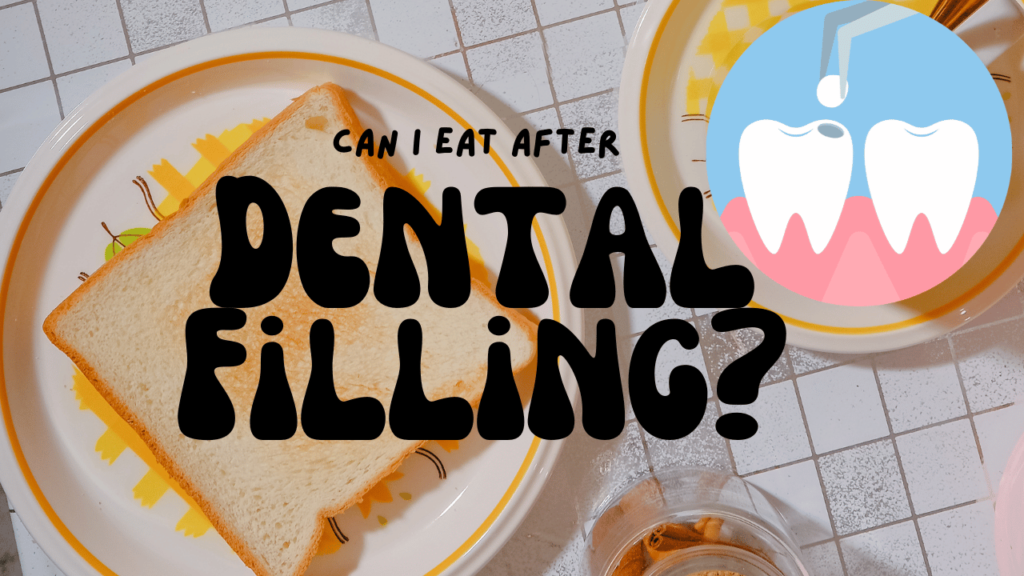Introduction
“Can I Eat After a Dental Filling?” This question often lingers in the minds of many patients after undergoing dental filling procedures. Understanding the dos and don’ts following a dental filling is crucial for ensuring not just the longevity of the dental work but also for maintaining overall oral health.
Dental fillings, a fundamental aspect of restorative dentistry, are designed to repair and restore teeth affected by decay or damage. When a tooth develops a cavity or suffers a fracture, a filling helps to restore its original structure and function. This treatment prevents further decay and maintains the tooth’s integrity. Dental fillings come in various types, including metal amalgam and composite resin, each serving the same purpose but with different properties and considerations.
The concern about can I eat after a dental filling and what to avoid post-filling is not just about comfort—it’s also about safeguarding your dental health and ensuring the effectiveness of the treatment. As we delve deeper into this topic, we aim to provide clear, factual, and practical guidelines for those in Boston and beyond, seeking to navigate their dietary choices after a dental filling.
Understanding Different Types of Fillings
When pondering the question, “Can I Eat After a Dental Filling?”, it’s essential to first understand the types of fillings used in dentistry. Each type has unique characteristics that influence post-treatment care.
- Amalgam Fillings: Often known as ‘silver fillings’, amalgam fillings are a time-tested solution. They are durable, made from a mixture of metals like silver, mercury, tin, and copper, making them ideal for filling cavities in back teeth where chewing pressure is greatest.
- Composite Fillings: These are tooth-colored and made from a mixture of plastic and fine glass particles. Composite fillings are popular due to their aesthetic appeal, as they blend seamlessly with the natural color of teeth. They are best suited for visible areas of the mouth.
- Gold Fillings: Though less common, gold fillings are prized for their durability and strength. They are typically more expensive and are noticeable when you smile or open your mouth.
Eating After a Dental Filling
A common query many have after dental work is, “Can I Eat After a Dental Filling?” The answer varies based on the type of filling you’ve received.
- Composite Fillings: If you’ve had a composite filling, good news! These fillings harden immediately under UV light used during the procedure. Generally, you can eat immediately after the filling is placed. However, due to potential numbness from the anesthetic, it’s wise to wait until this wears off, which typically takes about two hours, to prevent accidentally biting your cheek or tongue.
- Amalgam Fillings: For amalgam or metal fillings, the advice is a bit different. These fillings take longer to set, typically around 24 hours. To avoid disrupting the filling, it’s recommended to avoid eating on the side of the mouth where the filling was placed for this duration.
- Gold Fillings: Similar to amalgam fillings, gold fillings also require a period of setting. It’s advisable to wait at least a day before eating hard or crunchy foods.
In all cases, after a dental filling, sticking to softer foods and avoiding extremes in temperature can help in minimizing discomfort and ensuring the filling sets correctly.
Foods to Avoid and Safe Choices
Once your dental filling is in place, a critical question arises: “Can I Eat After a Dental Filling?” and importantly, what foods to avoid to prevent discomfort or damage.
- Hard foods like nuts and candy can crack or dislodge the filling.
- Sticky foods such as caramel or taffy can pull at the filling.
- Extremely hot or cold foods might trigger sensitivity or pain due to contraction or expansion of the tooth.
Safe Food Choices:
- Soft foods like yogurt, mashed potatoes, and scrambled eggs are gentle on fillings.
- Lukewarm soups and smoothies are comfortable for sensitive teeth.
- Well-cooked, soft vegetables and fruits, and grain dishes like oatmeal, ensure minimal discomfort.
In the initial days post-treatment, these dietary adjustments can aid significantly in the healing process and the longevity of your dental filling. This is the answer to the question “Can I Eat After a Dental Filling?”
Caring for Your Dental Filling
After getting a dental filling, the question “Can I Eat After a Dental Filling?” extends to caring for your filling to ensure its longevity. Proper care not only involves cautious eating but also includes overall dental hygiene and regular check-ups. Here are some tips:
- Regular Dental Hygiene: Brush twice daily using fluoride toothpaste and don’t skip flossing. Good oral hygiene prevents decay around the filling.
- Avoid Excessive Pressure: Be mindful of chewing hard foods or ice, as these can strain the filling.
- Regular Dental Check-ups: Visit your dentist regularly to ensure the filling remains intact and effective. They can spot and address any potential issues early.
- Be Aware of Sensitivity: Some sensitivity post-filling is normal. However, if discomfort persists, consult your dentist.
- Avoid Teeth Grinding: If you grind your teeth, consider using a mouthguard. Grinding can wear down fillings.
By following these steps, you can maintain the integrity and extend the life of your dental filling, ensuring continued oral health.
When to Consult Your Dentist
After a dental filling, knowing when to consult your dentist is crucial for your oral health. If you’re questioning, “Can I Eat After a Dental Filling?” and experience any of the following signs, it’s time to schedule a follow-up:
- Prolonged Sensitivity or Pain: Some sensitivity is normal, but if it lasts more than a week or is severe, see your dentist.
- Issues with Biting: If your bite feels uneven or the filling seems too high, your dentist may need to adjust it.
- Signs of Infection: Swelling, severe pain, or fever could indicate an infection.
- Loose or Damaged Filling: If the filling feels loose, cracks, or falls out, it requires immediate attention.
Regular dental check-ups are also vital. They help in monitoring the condition of your filling and overall dental health, ensuring any issues are caught and addressed early.
Conclusion
In conclusion, understanding what to eat and how to care for your dental filling is pivotal for optimal healing and maintaining dental health. “Can I Eat After a Dental Filling?” is a common concern, and the guidelines provided here aim to ease this worry. Remember, the type of filling, the foods you choose, and how you care for your teeth post-procedure play significant roles in your dental health journey.
Every individual’s dental needs are unique, and while these guidelines serve as a general roadmap, consulting with your dentist for personalized advice and care is always recommended. Adhering to their expert guidance ensures not only the longevity of your dental work but also your continued oral well-being.
FAQ’s
- How long after a filling can you eat normal food?
- Composite fillings harden immediately, so you can eat right after. For amalgam fillings, it’s best to wait 24 hours.
- What should I avoid eating after a filling?
- Avoid hard, sticky, sugary, and extremely hot or cold foods for at least 24 hours.
- What are the do’s and don’ts after a teeth filling?
- Do: Maintain good oral hygiene, eat soft foods initially.
- Don’t: Chew hard foods on the filling, ignore prolonged sensitivity.
- How long does it take for a filling to fully heal?
- The filled tooth itself can be used immediately, but full adaptation and sensitivity reduction might take a few days to a week.
- How long does it take for a deep filling to settle down?
- Deep fillings may cause sensitivity for a few days to a week. If discomfort persists, consult a dentist.
- Can I eat after a dental filling?
- If it’s a composite filling, yes, but be cautious of temperature. For amalgam, wait 24 hours.
- How long does it take for a tooth nerve to heal after filling?
- It varies, but usually, any sensitivity or discomfort should lessen within a week.
- How fast do fillings harden?
- Composite fillings harden immediately under UV light. Amalgam fillings take about 24 hours to fully harden.
- Do deep fillings lead to root canals?
- Not necessarily, but deep fillings close to the nerve can increase the risk. If there’s persistent pain, a root canal may be needed.


